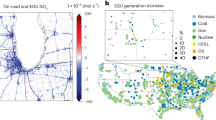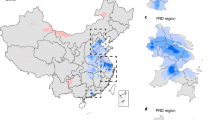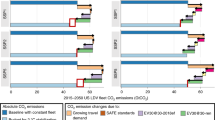Abstract
Non-CO2 air pollutants from motor vehicles have traditionally been controlled to protect air quality and health, but also affect climate. We use global composition–climate modelling to examine the integrated impacts of adopting stringent European on-road vehicle-emission standards for these pollutants in 2015 in many developing countries. Relative to no extra controls, the tight standards lead to annual benefits in 2030 and beyond of 120,000–280,000 avoided premature air pollution-related deaths, 6.1–19.7 million metric tons of avoided ozone-related yield losses of major food crops, $US0.6–2.4 trillion avoided health damage and $US1.1–4.3 billion avoided agricultural damage, and mitigation of 0.20 (+0.14/−0.17) °C of Northern Hemisphere extratropical warming during 2040–2070. Tighter vehicle-emission standards are thus extremely likely to mitigate short-term climate change in most cases, in addition to providing large improvements in human health and food security. These standards will not reduce CO2 emissions, however, which is required to mitigate long-term climate change.
This is a preview of subscription content, access via your institution
Access options
Subscribe to this journal
Receive 12 print issues and online access
$209.00 per year
only $17.42 per issue
Buy this article
- Purchase on Springer Link
- Instant access to full article PDF
Prices may be subject to local taxes which are calculated during checkout



Similar content being viewed by others
References
Streets, D. G. et al. An inventory of gaseous and primary aerosol emissions in Asia in the year 2000. J. Geophys. Res. 108, 8809 (2003).
Marland, G., Boden, T. A. & Andres, R. J. in Global, Regional, and National Fossil Fuel CO2 Emissions (Trends: A Compendium of Data on Global Change, US Department of Energy, 2008).
Uherek, E. et al. Transport impacts on atmosphere and climate: Land transport. Atmos. Environ. 44, 4772–4816 (2010).
Balkanski, Y. et al. Direct radiative effect of aerosols emitted by transport: from road, shipping and aviation. Atmos. Chem. Phys. 10, 4477–4489 (2010).
Unger, N., Shindell, D. T. & Wang, J. S. Climate forcing by the on-road transportation and power generation sectors. Atmos. Environ. 43, 3077–3085 (2009).
Fuglestvedt, J., Berntsen, T., Myhre, G., Rypdal, K. & Skeie, R. B. Climate forcing from the transport sectors. Proc. Natl Acad. Sci. USA 105, 454–458 (2008).
Fuglestvedt, J. S. et al. Transport impacts on atmosphere and climate: Metrics. Atmos. Environ. 44, 4648–4677 (2010).
Shindell, D. et al. Climate forcing and air quality change due to regional emissions reductions by economic sector. Atmos. Chem. Phys. 8, 7101–7113 (2008).
Fulton, L. & Eads, G. IEA/SMP Model Documentation and Reference Case Projections 1–92 (International Energy Agency World Business Council for Sustainable Development, 2004).
Boucher, O., Friedlingstein, P., Collins, B. & Shine, K. P. The indirect global warming potential and global temperature change potential due to methane oxidation. Environ. Res. Lett. 4, 044007 (2009).
Shindell, D. & Faluvegi, G. The net climate impact of coal-fired power plant emissions. Atmos. Chem. Phys. 10, 3247–3260 (2010).
Shindell, D. et al. Spatial scales of climate response to inhomogeneous radiative forcing. J. Geophys. Res. 115, D19110 (2010).
Raes, F. & Seinfeld, J. H. New directions: Climate change and air pollution abatement: A bumpy road. Atmos. Environ. 43, 5132–5133 (2009).
Flanner, M. G., Zender, C. S., Randerson, J. T. & Rasch, P. J. Present-day climate forcing and response from black carbon in snow. J. Geophys. Res. 112, D11202 (2007).
Koch, D. et al. Distinguishing aerosol impacts on climate over the past century. J. Clim. 22, 2659–2677 (2009).
Wang, C., Kim, D., Ekman, A. M. L., Barth, M. C. & Rasch, P. J. Impact of anthropogenic aerosols on Indian summer monsoon. Geophys. Res. Lett. 36, L21704 (2009).
Ramanathan, V. & Carmichael, G. Global and regional climate changes due to black carbon. Nature Geosci. 1, 221–227 (2008).
Meehl, G., A., Arblaster, J. M. & Collins, W. D. Effects of black carbon aerosols on the Indian monsoon. J. Clim. 21, 2869–2882 (2006).
Ming, Y. & Ramaswamy, V. Nonlinear climate and hydrological responses to aerosol effects. J. Clim. 22, 1329–1339 (2009).
Rotstayn, L. D. & Lohmann, U. Tropical rainfall trends and the indirect aerosol effect. J. Clim. 15, 2103–2116 (2002).
Chung, S. H. & Seinfeld, J. Climate response of direct radiative forcing of anthropogenic black carbon. J. Geophys. Res. 110, D11102 (2005).
Smith, K. R. et al. Public health benefits of strategies to reduce greenhouse-gas emissions: Health implications of short-lived greenhouse pollutants. Lancet 374, 2091–2103 (2009).
Haines, A. et al. Public health benefits of strategies to reduce greenhouse-gas emissions: Overview and implications for policy makers. Lancet 374, 2104–2114 (2009).
Shindell, D. T. et al. Simulations of preindustrial, present-day, and 2100 conditions in the NASA GISS composition and climate model G-PUCCINI. Atmos. Chem. Phys. 6, 4427–4459 (2006).
Schwarz, J. P. et al. Coatings and their enhancement of black carbon light absorption in the tropical atmosphere. J. Geophys. Res. 113, D03203 (2008).
Lamarque, J. F. et al. Historical (1850–2000) gridded anthropogenic and biomass burning emissions of reactive gases and aerosols: Methodology and application. Atmos. Chem. Phys. 10, 7017–7039 (2010).
Penner, J. E. et al. Model intercomparison of indirect aerosol effects. Atmos. Chem. Phys. 6, 3391–3405 (2006).
Forster, P. et al. in IPCC Climate Change 2007: The Physical Science Basis (eds Solomon, S. et al.) (Cambridge Univ. Press, 2007).
Shindell, D. & Faluvegi, G. Climate response to regional radiative forcing during the 20th century. Nature Geosci. 2, 294–300 (2009).
Hegerl, G. C. et al. in IPCC Fourth Assessment Report (eds Solomon, S. et al.) (Cambridge Univ. Press, 2007).
Krewski, D. et al. Extended Follow-up and Spatial Analysis of the American Cancer Society Study Linking Particulate Air Pollution and Mortality 140 (Health Effects Institute, 2009).
Jerrett, M. et al. Long-term ozone exposure and mortality. New Engl. J. Med. 360, 1085–1095 (2009).
Anenberg, S. C., Horowitz, L. W., Tong, D. Q. & West, J. J. An estimate of the global burden of anthropogenic ozone and fine particulate matter on premature human mortality using atmospheric modelling. Environ. Health Perspect. 118, 1189–1195 (2010).
Cohen, A. J. et al. Comparative Quantification of Health Risks (World Health Organization, 2004).
Van Dingenen, R. et al. The global impact of ozone on agricultural crop yields under current and future air quality legislation. Atmos. Environ. 43, 604–618 (2009).
Cropper, M. L. & Oates, W. E. Environmental economics: A survey. J. Econ. Lit. 30, 675–740 (1992).
Viscusi, W. K. & Aldy, J. E. The value of a statistical life: A critical review of market estimates throughout the world. J. Risk Uncert. 27, 5–76 (2003).
USEPA The Benefits and Costs of the Clean Air Act: 1990–2010. EPA Report to Congress (Office of Air and Radiation, Office of Policy, 1999).
Muller, N. Z. & Mendelsohn, R. Measuring the damages of air pollution in the United States. J. Environ. Econ. Manag. 54, 1–14 (2007).
Acknowledgements
We thank the NASA Applied Sciences program, the ClimateWorks Foundation and the California Air Resources Board for supporting this work. We also thank T. Bond for gridding the emissions, M. Brauer for providing the PM2.5-measurement database, J. West for assistance with the population projection, B. Croes and D. Luo at CARB for their assistance and the UNEP/WMO Integrated Assessment of Black Carbon and Tropospheric Ozone team for discussions. Conclusions expressed in this article are the authors and do not necessarily represent those of their employers.
Author information
Authors and Affiliations
Contributions
D.S. planned and led the work and writing of the paper. G.F. carried out the composition–climate modelling. M.W. carried out the emissions analyses. S.C.A. and J.A. carried out the health analyses. R.V.D. carried out the crop-yield and valuation analysis. N.Z.M. carried out the health valuation analysis. D.K. provided input on aerosol modelling. G.M. analysed the composition–climate model output. All contributed to writing the paper.
Corresponding author
Ethics declarations
Competing interests
The authors declare no competing financial interests.
Supplementary information
Supplementary information
Supplementary information (PDF 1525 kb)
Rights and permissions
About this article
Cite this article
Shindell, D., Faluvegi, G., Walsh, M. et al. Climate, health, agricultural and economic impacts of tighter vehicle-emission standards. Nature Clim Change 1, 59–66 (2011). https://doi.org/10.1038/nclimate1066
Received:
Accepted:
Published:
Issue Date:
DOI: https://doi.org/10.1038/nclimate1066
This article is cited by
-
Effect of Al-Si Coating Removal State on Microstructure and Mechanical Properties of Laser Welded 22MnB5 Steel
Journal of Materials Engineering and Performance (2023)
-
Can China’s vehicular emissions regulation reduce air pollution?—a quasi-natural experiment based on the latest National Vehicular Emissions Standard (stage-VI)
Environmental Science and Pollution Research (2023)
-
Temporal profiles of ambient air pollutants and associated health outcomes in two polluted cities of the Middle East
Journal of Environmental Health Science and Engineering (2022)
-
A review of factors and benefits of non-motorized transport: a way forward for developing countries
Environment, Development and Sustainability (2022)
-
10 years of Nature Climate Change
Nature Climate Change (2021)



